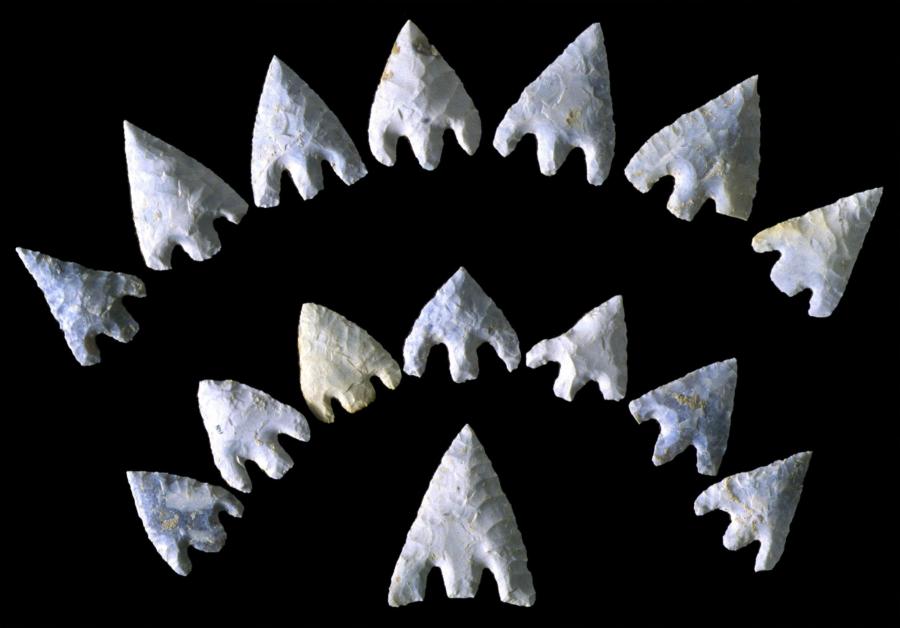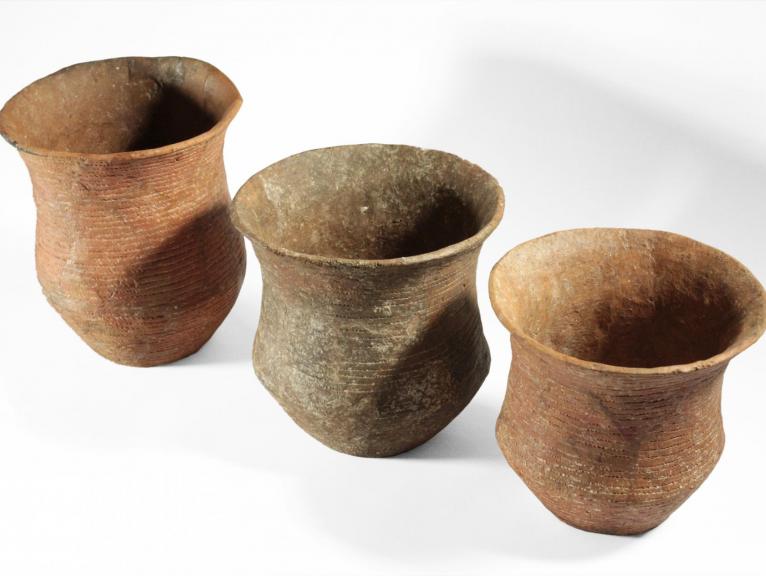The Amesbury Archer: 20 Years On
-
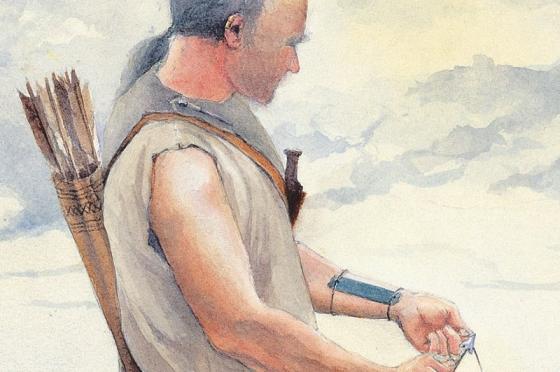
3rd May 2002
Discovery
On the 3rd of May 2002 Wessex Archaeology excavated the grave of a man dating to around 2,300BC. Discovered three miles from Stonehenge his grave contained the richest array of items ever found from this period. Around 100 objects were found, including the complete skeleton of a man, three copper knives, two small gold hair ornaments, two wristguards to protect his wrists from the bow string, 16 flint arrowheads and five pots.
The Amesbury Archer’s grave is closely associated with that of another younger man, known as the ‘Companion’, buried just three metres away.
Now, 20 years on, subsequent years of research and development mean we continue to learn and discover more about the life of a man at the centre of Early Bronze Age society.
The Amesbury Archer comprises one of over 30 individuals of Beaker/Early Bronze Age date whose remains have been found at Amesbury Down on the margins of Salisbury Plain in Wiltshire, UK. The Beaker period represents a phenomenon which stretched from northern Scotland to North Africa and from western Spain over to Russia covering the Late Neolithic into the Early Bronze Age, sometimes known as the Chalcolithic. The Beaker period is so called because of the distinctive Beaker pottery forms used by these population groups, several examples of which were recovered from the Amesbury Archer’s grave.
The Amesbury Archer is important for many reasons. His grave is the richest of any found from the Beaker period (2400 - 1800 BC), which spans the latter part of the Late Neolithic into the early part of the Early Bronze Age.
This was a time when the first metals were brought to Britain, and the Archer was buried with two gold hair ornaments which are the oldest securely dated gold ever found here (dated to around 2,400 BC).
Recent strontium and oxygen isotope analyses have confirmed that, having spent his childhood in Central Europe, the Amesbury Archer was one of the first individuals linked to the Beaker phenomenon to reside in Britain.
-
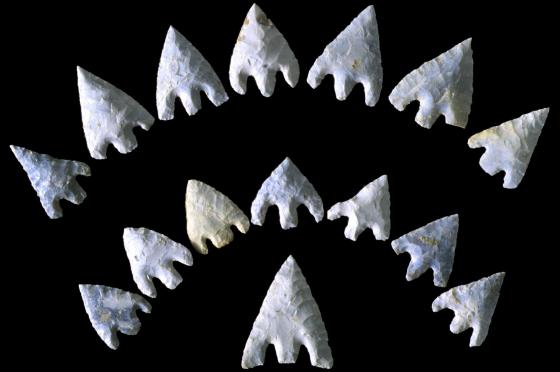
3rd May 2002
Barbed and tanged arrowheads
Fifteen barbed and tanged arrowheads and a probable triangular arrowhead were recorded as part of the remains of the Amesbury Archer’s burial. Fourteen of these were found towards the eastern end of the grave in a scatter extending from the pelvis to the feet. A cluster of nine arrowheads were found at the front of the knees and a further six lay over the pelvis and lower legs. These six arrowheads were at a higher level and were likely laid over the body in the final stages of the burial. It's possible that the arrowheads were attached to the shafts although we can't say conclusively due to post-depositional changes within the grave.
The quantity of barbed and tanged arrowheads found in the Amesbury Archer’s grave rank as one of the largest recorded in Britain. Although barbed and tanged arrowheads are a common feature of male Beaker period burials, they are typically found as single finds or in pairs. The wealth of arrowheads accompanying the Amesbury Archer make his burial remains an excellent starting point for comparative study. The ‘typical’ arrowhead from the burial is approx. 22 – 30 mm in length, 18 – 22mm in width and 3 – 5 mm in thickness.
-
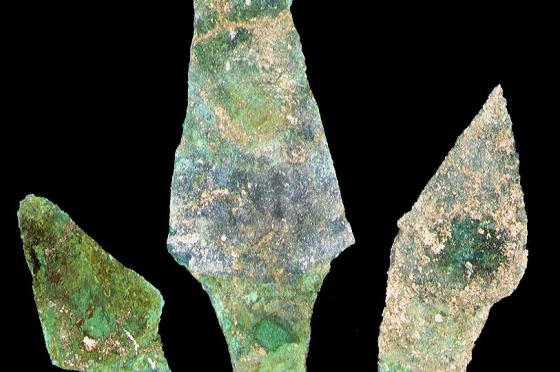
3rd May 2002
The Amesbury Archer’s dagger and knives
The Amesbury Archer was buried with three implements – two knives and one dagger. All three are tanged (of triangular or leaf shape with a small projection at the base for the attachment of a handle) and made of copper. By assessing attributes for each blade, we have been able to place these blades in the context of other types found in other graves.
Beaker period dagger implements tend to be uniform so special attention was paid to Continental comparisons to hypothesise what this blade might have meant to the Amesbury Archer. Several good matches for the Amesbury blades were found and allowed us to conclude that the squat triangular form of the two smaller blades was widespread across the Beaker domains of western Europe.
The knife on the left and dagger in the centre of this image also contained very similar chemical compositions and are of a material akin to Bell Beaker metal. However, the knife on the right had a different chemical composition which corresponds with copper artefacts from western France but does not occur frequently within copper metalwork across Britain and Ireland.
This means the metal composition of the Amesbury Archer’s blades presents a spectrum stretching from the Lower Rhine through to northern and western France. From this we can conclude that even if the Amesbury Archer brought the dagger and knives with him from the south-east, the metals they contained were almost certainly from western Europe.
For the two left hand blades in this image, we cannot assume that their Bell Beaker metal make up means they were imported from the Continent although the rare composition of the third blade means the metal for the blade is highly likely to have originated in western France or Iberia (modern day Spain and Portugal) if not the knife itself. The different origins of the blades could have given each blade a different significance in the eyes of the Amesbury Archer. Possessing blades from these varied sources may even have given the Amesbury Archer social capital amongst his early Beaker peers.
-
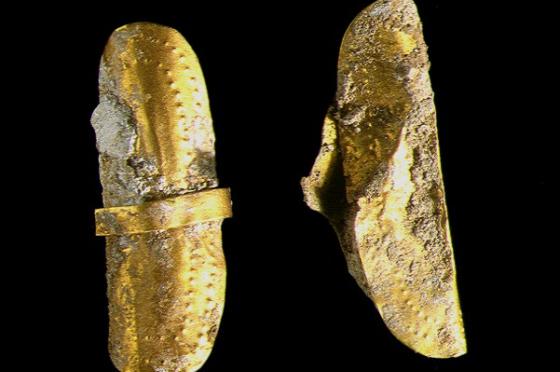
3rd May 2002
Gold hair ornaments from the remains of the Amesbury Archer’s burial and the ‘Companion’
Two pairs of Gold Basket-Shaped ornaments (hair ornaments) were found, one pair was found in the Amesbury Archer’s grave and the other from that of the 'Companion’.
In the Amesbury Archer’s case the gold ornaments were found in front of the knees.
A pair of gold ornaments were also recovered during the cleaning of the ‘Companion’ skeleton. The two ornaments were wrapped together and were found up against the inside of the mandible (lower jaw) on the right side.
These gold ornaments are special as their early Beaker period association places them amongst the earliest goldwork in north-western Europe. Such items are most frequently found in British contexts and, at present, there is little evidence that the style gained popularity elsewhere in western Europe. Questions remain as to whether the British style drew on central European Beaker types or whether the style originated in Britain.
The lower copper content of the ‘Companion’s’ gold basket-shaped ornaments speak to primary Beaker period goldwork from Britain. The higher copper content in the Amesbury Archer’s ornaments could then suggest that the gold for the manufacture in this case might have originated from a different source.
-
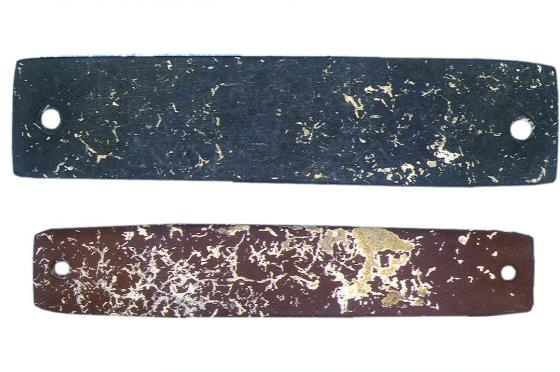
3rd May 2002
The Amesbury Archer’s Two Wristguards
Two bracers (wristguards) were found amongst the remains within the Amesbury Archer’s grave. One example, red in colour, was found by the knees and another, black or dark grey, example was found next to the left forearm (to which it may well have been attached at the time of burial). The earliest radiocarbon dates for braces such as that found with the Amesbury Archer are for artefacts from Iberia, suggesting bracers may have originated here.
Finely crafted stone bracers, like the ones found buried with the Amesbury Archer, were likely not intended for regular, everyday use. The high proportion of bracers from burials found on the outside of the arm in other contexts in fact suggest these were items for display rather than serving a practical purpose. Bracers have also been found in central European burials and elsewhere with prestigious objects. Such symbolic deposits suggest high social rank indicated by items of continental style.
-
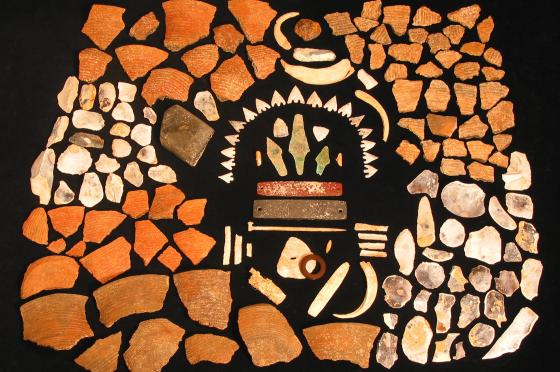
3rd May 2002
Flint
All the flints found with the Amesbury Archer are in perfect condition except for one broken flake which is thought to be residual. Further research on the Amesbury Archer will determine whether these were deliberate grave good depositions or were accidentally included in the refilling of the Amesbury Archer’s grave.
-
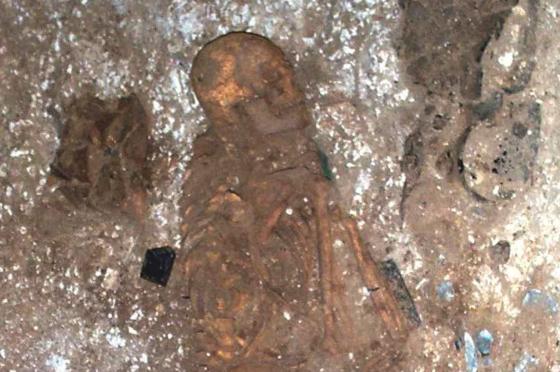
3rd May 2022
DNA Analysis of the Amesbury Archer and the ‘Companion’
Previous research on the Amesbury Archer has speculated that the Archer and the ‘Companion’ may have been related due to the similarities between their grave goods and a shared physical trait – a skeletal variation in their feet where the heel bone (calcaneum) and the bone at the top of the foot (navicular) were joined by fibrous tissue. This hypothesis seemed all the more likely considering this particular trait occurs in only 1.5 – 2.9 % of recorded modern populations and has high hereditability.
Recent DNA analysis using samples from the teeth of the Amesbury Archer and the ‘Companion’ has shed new light on this hypothesis. DNA of both individuals showed they were descended from what are known as Early European Farmers. Although this was a genetic type commonly seen in Beaker males across Europe, with migrants moving over an extended period westward into Britain, these migrants did not derive from a single (homogeneous) population group. The Archer had too little Steppe ancestry to form part of the population that came to dominate the Beaker and Early Bronze Age period in Britain; the ‘Companion’, however, fell within this latter grouping.
The finer details available through DNA analysis show that the Amesbury Archer and the ‘Companion’ were not first-degree relatives, e.g., father and son, and nor were they second-degree relatives, e.g., grandfather and grandson. Nevertheless, the possibility remains that the Amesbury Archer and the ‘Companion’ may have been more distantly related. This could include third-degree relations such as that between great grandparents and greatgrandchildren. Over the next 20 years, we hope that further developments in science will be able to confirm their biological relationship.
-
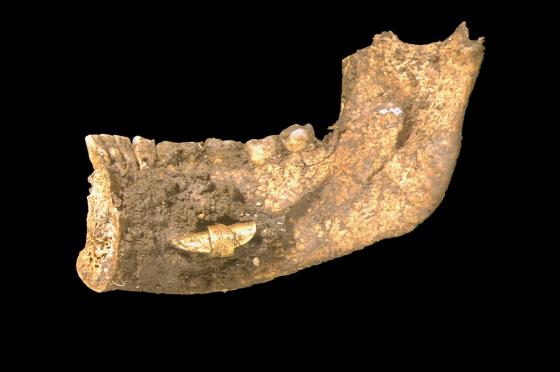
February - July 2022
The Amesbury Archer at the World of Stonehenge exhibit
Some the finds from the grave of the Archer are on display in The World of Stonehenge, an exhibition running at the British Museum between 17 February and 17 July 2022.


i) The remains of the Amesbury Archer's burial, ii) The plan of the finds associated with the remains of the grave
